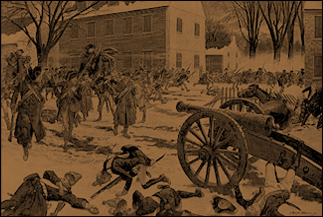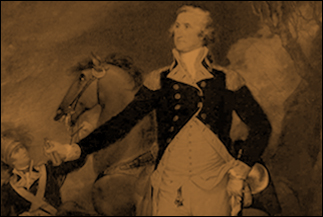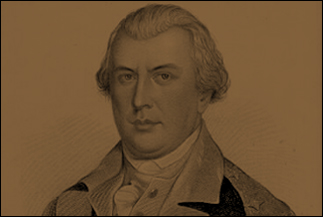The 1st Battle of Trenton, American Attack
An outpost was set up by the Hessians, at a cooper shop on Pennington Road, about one mile north-west of Trenton. George Washington himself led the assault, riding in front of his soldiers. The Hessian commander of the outpost, Lieutenant Andreas von Wiederholdt, came out of the shop to get some fresh air, and an American fired at him. Wiederholdt shouted "The Enemy!" and other Hessians came out. The Americans fired three volleys at them and the Hessians returning one of their own. Washington ordered Edward Hand's Pennslyvania Riflemen and a battalion of German-speaking infantry to block the road that led to Princeton, and they did so attack the Hessian outpost there. Wiederholdt soon realized it was more than just a raiding party, and he saw the other Hessians retreating from the outpost on the Princeton Road, and he decided to do the same.
 Battle of Trenton
Battle of Trenton
 George_Washington
George_Washington
 General John Sullivan
General John Sullivan
 General Nathanael Greene
General Nathanael Greene
Both of the Hessian detachments led an organized retreat, firing as they fell back. They fell back to the high ground at the north end of Trenton, where they were joined by a duty company from the Lossberg Regiment. They engaged the Americans, retreating slowly, keeping up continuous fire and using houses and other building for cover. Once in Trenton they began to receive support from other Hessian guard companies on the outskirts of the town. Another guard company nearer to the Delaware River rushed east to their aid, leaving open the River Road into Trenton. Washington ordered that the escape route to Princeton be cut off, sending infantry in battle formation to block it off, while artillery formed at the head of King and Queen streets.
General John Sullivan, leading the southern American column entered Trenton on the abandoned river road, and made hard for the only crossing over the Assunpink Creek, which was the only way out of Trenton to the south, in hopes of cutting off the Hessian escape. Sullivan briefly held up his advance in order to make sure that Greene's division had time to drive the Hessians from their outposts in the north. Soon after, they continued their advance, attacking the Hermitage, home of Philemon Dickinson, where 50 Jägers under the command of Lieutenant von Grothausen were stationed. Lieutenant von Grothausen brought 12 of his Jägers into action against the advanced guard, but had only advanced a few hundred yards when he saw a column of Americans advancing to the Hermitage. He pulled back to the Hessian barracks, and was joined by the rest of the Jägers, who had evacuated the Hermitage. After one volley, they turned and ran, some trying to swim across the creek, while others escaped over the bridge, which had not yet been cut off. The 20 British Dragoons present also fled at this time. As Greene and Sullivan's columns pushed into the town, Washington moved to high ground north of King and Queens streets so he could see the action, and direct his troops. At this time, artillery from the other side of the Delaware River came into action, devastating the Hessian positions.
The alarm soon sounded and the three regiments began to prepare for battle. The Rall regiment formed on lower King Street along with the Lossberg Regiment, while the Knuphausen Regiment formed at the lower end of Queen Street. Lieutenant Piel, Rall's brigade adjutant, finally awoke his commander, who found that the rebels had taken the "V" of the main streets of the town where earlier that month the engineers would have constructed the redoubt. Rall ordered his own regiment to form up at the lower end of King Street, the Lossberg regiment to prepare for an advance up Queen Street, and the Knyphausen regiment to stand by as a reserve for Rall's advance up King Street.
The American cannon that had been stationed at the head of the two main streets soon came into action. In reply, Rall directed his regiment, supported by a few companies of the Lossberg regiment, to clear the guns. The Hessians formed into their ranks, and began to advance up the street, but their formations were quickly broken by the Americans guns, and fire from Mercer's men who had taken the houses on the left side of the street. Their ranks broke, and the Hessians fled. Rall then ordered two three-pound cannon into action. The cannon managed to get off six rounds each, but within just a few minutes, half of the Hessians manning their guns were killed by the American cannon. The remaining men fled to cover behind houses and fences, and the cannon were taken by the Americans. At once following the capture on the cannon, men under the command of George Weedon advanced down King Street.
On Queen Street, all Hessian attempts to advance up the street by the Lossberg and the Rall regiments were repulsed by guns under the command of Thomas Forrest. Two more Hessian guns were silenced, after they had only fired four rounds each. One of Forrest's Howitzers was put out of action with a broken axle. The Hessians soon fell back to a field outside the town, taking heavy losses from grapeshot and musket fire. In the southern part of the town, under the command of Sullivan, the Americans began to overwhelm the Hessians. John Stark led a bayonet charge at the Knyphausen regiment, breaking down most resistance as most of the Hessian weapons could not fire, and Sullivan personally led a column of men to block off any more troops from escaping across the creek.
PREVIOUS: Crossing and March | The 1st Battle of Trenton Pt.I | NEXT: The 1st Battle of Trenton Pt.II




